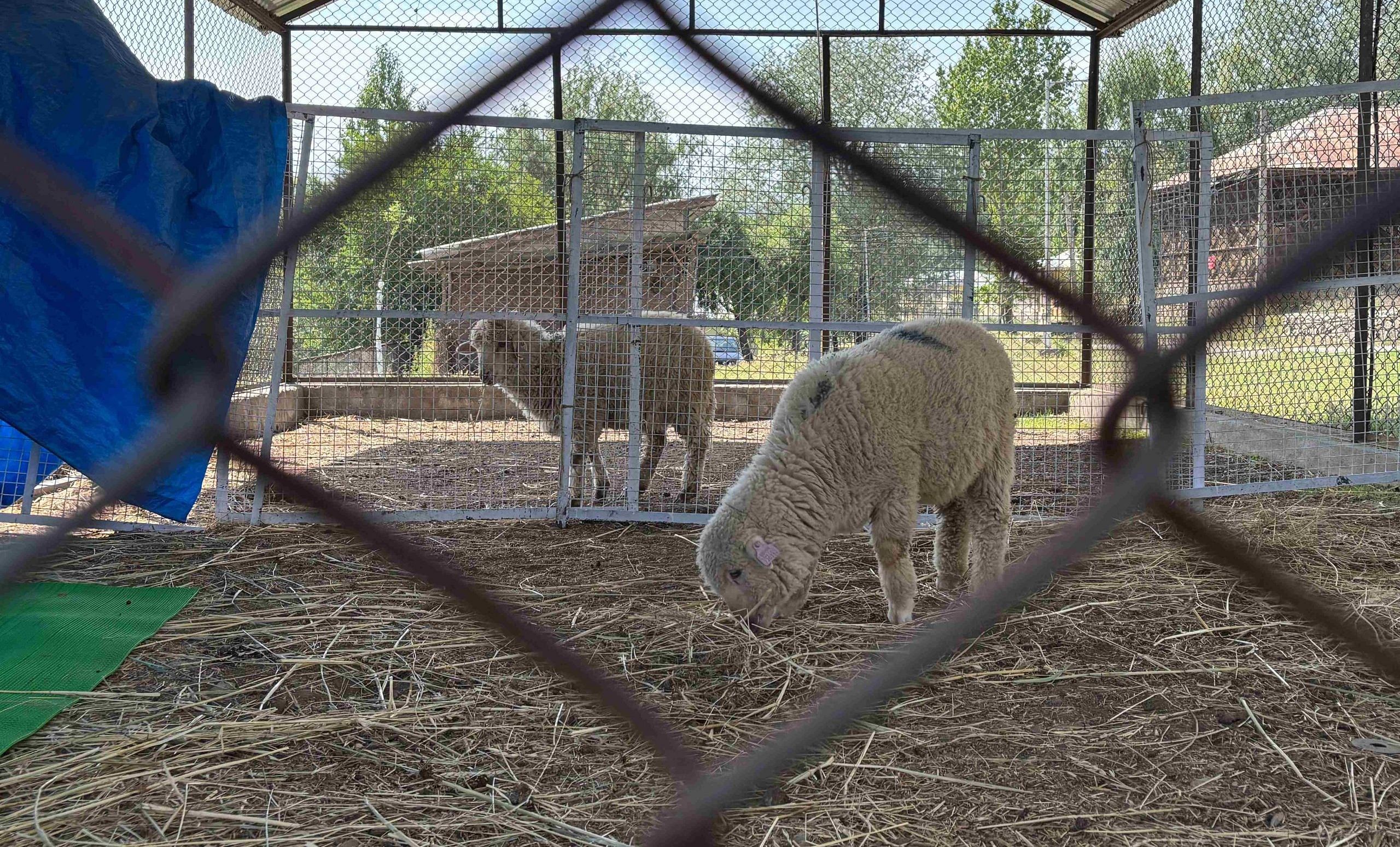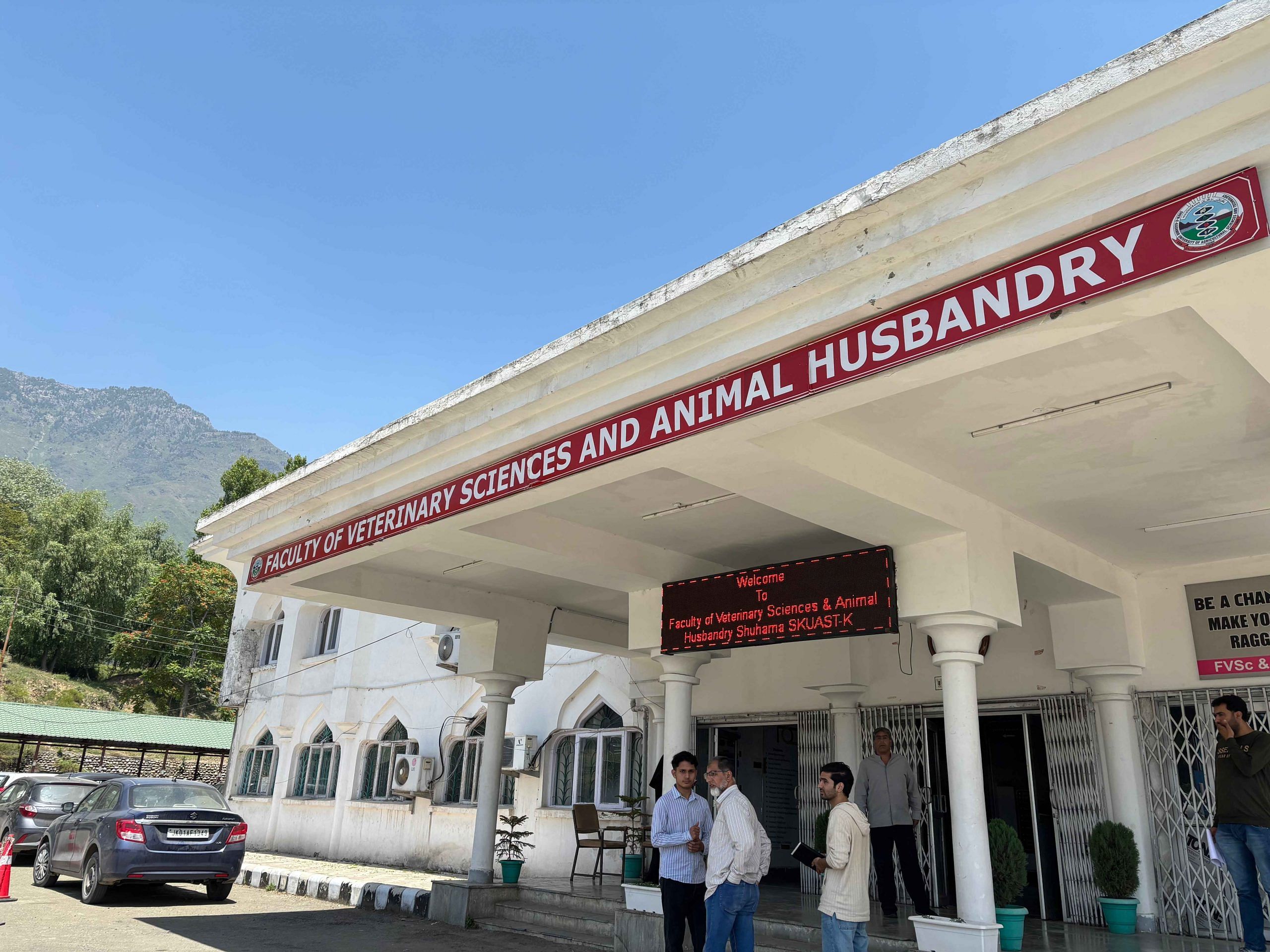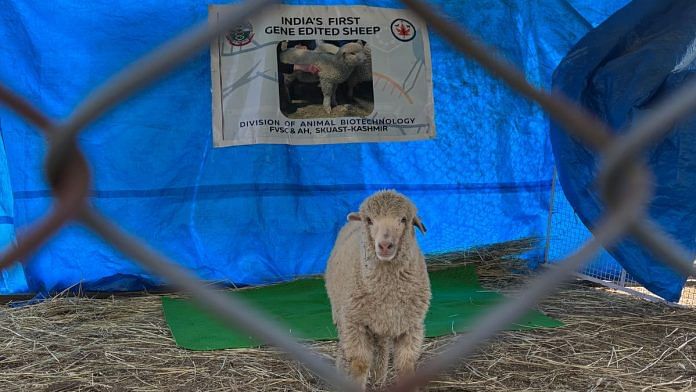Srinagar: Kashmir has a little lamb. And she is a bit of a celebrity too. Visitors throng to get a glimpse, take pictures all day. Scientists track every move of hers, taking notes on how she is growing.
She is, after all, India’s first gene-edited sheep. She has enhanced muscle mass as a result of successfully altered DNA.
There is a whole list of suggested names that the scientists at Srinagar’s Sher-e-Kashmir University of Agricultural Sciences and Technology (SKUAST) have sent all the way up to the university’s vice chancellor for approval.
In a region dominated by headlines of conflict, SKUAST is quietly making a mark with scientific innovations. And it has come with a lot of perseverance. It took Suhail Margey, his team of seven, and their supervisor—senior scientist Riaz Ahmad Shah—six years to reach this milestone.
Margey was midway through a meal of mutton and rice when his laptop chimed with news of another sheep. India’s first gene-edited farm animal had been born on the fifth trial. It was a Friday, and Margey’s prayers had been answered.

“This wasn’t just the birth of a lamb—it was a landmark moment in genome editing,” he said, clad in a white skull cap, his long beard flowing down to his chest. “I left dinner midway and settled on the couch to re-read the sequencing results.”
The goal
Kashmiri scientist Riaz Ahmad Shah was no stranger to failures and breakthroughs. In 2009, he cloned India’s first buffalo calf, Garima, during his PhD at the National Dairy Research Institute (NDRI) in Karnal. In 2012, he cloned the world’s first Pashmina goat, Noori.
Now, his student, PhD researcher Margey, is following the same path—adding another feather to the cap, and taking Kashmir’s cloning legacy one step further.
Margey’s idea was to target a gene in a sheep variety to boost muscle weight.
The team pitched it to the Indian Council of Agricultural Research (ICAR) and got funding from the National Agricultural Science Fund, setting the project in motion. Over the next half a decade, the team carried out nearly 400 trials. It began with embryo formation. Then came cloning. Strategies kept changing and evolving. They shifted from using dead animals to living ones. And pushed the research forward through repeated failures.

“DNA, in our language, is called the book of life. For a layman, you can think of DNA as letters. When you edit a gene, you fiddle with those letters,” said Shah, seated on a sofa at the Faculty of Veterinary Sciences and Animal Husbandry at SKUAST’s Shuhama campus. “In this case, we wanted to increase the muscle mass of a sheep’s body. So we identified and zeroed in on the myostatin gene—a negative regulator of muscle growth.”
The goal: make the sheep gain 30 per cent more muscle mass than normal.
“And once you knock off—or deactivate—that gene, you get more muscle mass,” Shah added.
Also read: ‘She ate too much chicken’—in Odisha’s Jajpur, confusion and grief after cholera deaths
Sister sheep
At the mountaintop Research Centre for Sheep and Goat at the Faculty of Veterinary Sciences and Animal Husbandry, two lambs chase each other inside a fenced enclosure. One stands out with a heavier, muscled body. The other looks like any ordinary sheep. A stark difference one cannot miss. These two female lambs were born to a single recipient female. But only one had the muscle-growth gene successfully altered.
Behind them, a poster reads: “India’s First Gene-Edited Sheep”. At the time of their birth, there was no visible physical difference between the two. Shah and Margey would visit the enclosure every other day, hoping to spot even the slightest variation.

“Edits made at the embryonic stage don’t result in immediate trait differences. But later, DNA sequencing confirmed that one of the lambs did carry the edited gene,” said Shah. Over the weeks, the difference became increasingly apparent.
Now, the two lambs—whom students, faculty, and scientists fondly call sisters—are being closely monitored to document their growth parameters.
Whenever visitors come, the non-gene-edited sister is moved to an adjoining room within the enclosure. The visitors marvel at the gene-edited sheep. Still, the other lamb makes her presence felt—scratching at the fence, eager to play with her sister.
“She just wants to come out and play with her sister,” said Mohammad Farooq, who feeds and watches over them during the day, laughing.
But the process to generate a gene-edited sheep wasn’t an easy one.
Trial and error
Creating a gene-edited lamb meant many sleepless nights in the lab for Margey. He had to leave his wife and two children at home, unable to give them the time. When he wasn’t in the lab, he was reading international research papers to refine his work. Otherwise, one would find him at SKUAST’s Advanced Centre for Reproductive Biotechnology lab.
This lab was developed during the birth of the Pashmina goat, Noori. And since then, the lab has dedicated sections for embryo handling, manipulation, incubation, and molecular work. Shah said the lab is the first one in Jammu and Kashmir and Ladakh, and has now become a reference point for many to follow.

The initial phases were full of hiccups. All the embryologists, molecular biologists, veterinary scientists, and technical staff were pushing through trial and error. In November 2019, cellular or gene-editing experiments were conducted for the first time. In 2020, the team moved on to embryo editing. Then they combined cloning with CRISPR editing and produced cloned embryos. It took 200 trials to produce embryos.“Only 10 per cent of trials were successful,” said Margey.
For two years, these embryos were transferred into the recipient sheep, but not a single pregnancy occurred.
Those were the days and nights when Margey prayed and spent much of his time with his supervisor, Shah. A towering figure with a calm, composed tone, Shah would often say, “Failure is also a step towards success. It means you tried. Not everyone does that.” And then Shah would take Margey through his years at National Dairy Research Institute in Karnal where he did his Phd in Animal cloning.
And during his research, which led to the first cloned calf in India, Garima, the cloning was not picking up. It took Shah two years of failures to make a breakthrough.
“I would talk to Riaz sahab. Sir was also married at that point in time and had two kids at home. And he had only visited his family three times in four years. Sir would say, ‘I was trying and trying through the failures,’” said Margey, smiling.
Also read: Helicopters are Kedarnath pilgrims’ favoured transport. It’s also the most dangerous
The breakthrough
It was not only Margey who was worried. Shah was equally anxious, he wanted his student to succeed.
One evening in 2023, he suddenly recalled a conference he attended a decade ago. It came to him like a flash. Shah had gone to New Zealand for a science conference as a visiting scientist. There he met scientists who were working on transgenic production. During a casual conversation, they mentioned that they were producing transgenic goats by extracting embryos from live animals. And that changed everything.
He quickly called Margey and suggested a change in the strategy—getting embryos from live animals. Earlier, the embryos were flushed out from slaughtered animals.
“Ovaries were collected from the slaughter house and we would take out eggs from those ovaries,” said Margey.

And then the strategy was changed. Eggs were now being collected from live animals through minor surgical procedures, with proper permission from the animal ethics committee. Soon, the team achieved pregnancies in sheep. But the pregnant sheep did not carry the edited gene.
“There were stillbirths initially. There were abortions. Some births didn’t survive. Some were born but didn’t have the edited gene,” recalled Shah, his face swept with seriousness. All the sheep were taken from the sheep farm at the university.
It was the fifth lamb that survived and eventually was found to have an edited gene. When Margey received the mail and called Shah at midnight, he wasn’t convinced. Next morning, the results were verified by several other scientists and finally, Margey got a nod.
Margey wept as Shah patted his back. “It was an equal achievement for me. My student had produced something that most veterinary scientists have been striving for,” said Shah.
Also read: Ahmadiyyas in Kashmir are branded as kafirs, boycotted, spat at. They hide, pass as Sunnis
Regulatory hurdles
It was 2015. Margey was 36, working as a veterinary inspector, when he made a decision that changed the course of his life. He applied for a PhD program at SKUAST. Already married and a father, it was a big decision for him personally and professionally. He had a dream: to work under Professor Riaz Ahmad Shah, a pioneer in veterinary science in India and a respected name internationally.
To his surprise, during Margey’s PhD viva, Shah was one of the panelists. When Shah asked him what he wanted to pursue for his research, Margey replied that he wanted to use CRISPR technology to create a gene-edited animal.
In future, when regulations are in place in India, the increased muscle mass will increase mutton production which shall fetch more price to the farmers as muscle is a major portion of meat besides other tissues
– PhD researcher Suhail Margey
No one had done this in India. Shah was impressed by Margey’s passion. CRISPR technology is considered a “revolutionary gene-editing technology that allows scientists to modify DNA sequences.”
Soon after, Margey found himself sitting with Shah, discussing how to make it happen. The animal they chose was a sheep. And they say that they did so for the animal farmers. With the absence of regulations for gene-editing in India, the entire process was strictly for research purposes.
“In future, when regulations are in place in India, the increased muscle mass will increase mutton production which shall fetch more price to the farmers as muscle is a major portion of meat besides other tissues,” said Margey.
However, India has lagged behind in adopting gene-editing technology compared to countries like the US and China. And the reason was regulatory hurdles and infrastructure.
But now, the country is beginning to pick up pace. In May this year, Union Agriculture and Farmers Welfare Minister Shivraj Singh Chouhan announced the launch of two genome-edited rice varieties.
“India lacks a regulatory framework for gene-editing livestock. The existing rules apply mainly to genetically modified crops. But ours is not genetically modified but edited and doesn’t fall in that category,” said Shah.
The first gene-modified animal in the world was a mouse created by Rudolf Jaenisch in 1974. He had introduced foreign DNA into the mouse embryo. But that was not a gene-edited/altered as Margey and Shah did. It was genetically modified by introducing a foreign gene.
In a research paper on gene editing, titled How genome editing changed the world of large animal research, authors Konrad Fischer and Angelika Schnieke write that the first large animal to undergo gene editing was a pig in 1985. The pig was developed by microinjection to “increase the growth of agricultural livestock.” But the lack of genome editing tools posed challenges in achieving full scope in the field.
But after the discovery of CRISPR in 2012, the world of gene-editing saw a transformational change. The creators of CRISPR, Emmanuelle Charpentier and Jennifer A Doudna, were also awarded the Nobel Prize in Chemistry in 2020. And it was the day of the Nobel Prize announcement that prompted Margey to use the technology for his experiment and research.
And with this, Shah’s stature at the university and beyond has grown further. His student made a breakthrough, and now more students want to pursue their PhDs under him. But Shah never intended to become a veterinary scientist.
“I wanted to be a doctor. I failed and became a veterinary scientist. Every veterinary scientist wanted to be a doctor once,” Shah laughed, as he bade goodbye to the sister lambs.
(Edited by Aamaan Alam Khan)





Do you know what it means to ” re- invent the wheel” ?